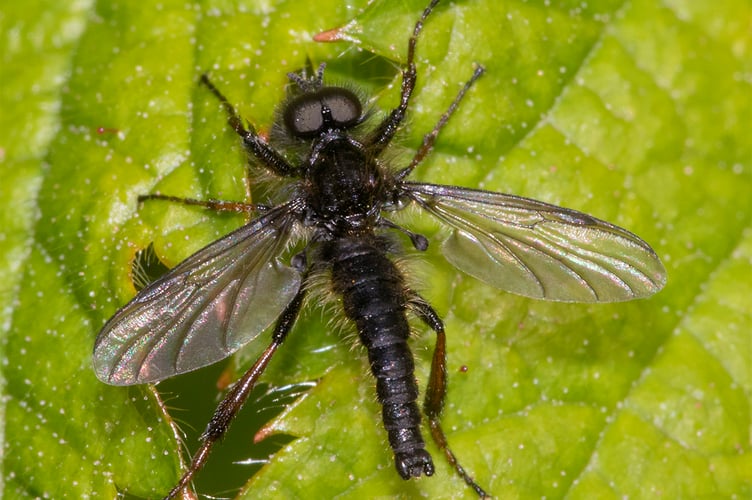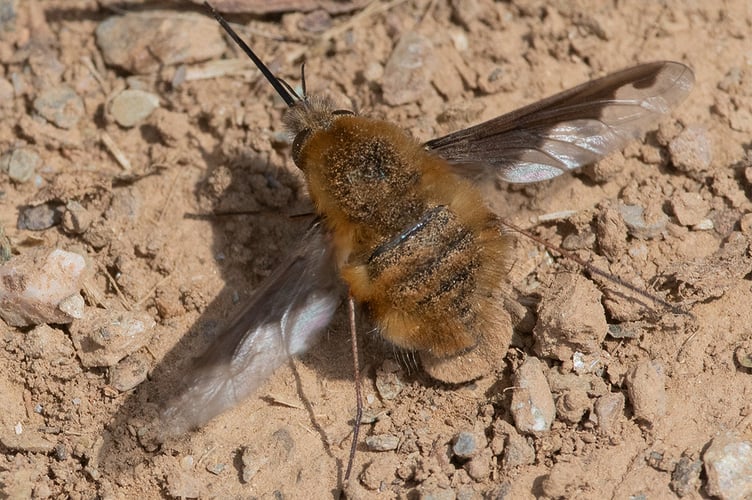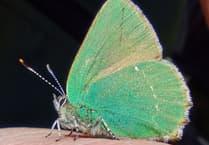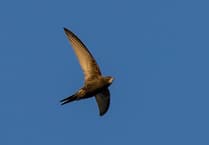St. Mark’s Flies (Bibio marci) traditionally appear on April 25 (St. Mark’s Day). During late April and May swarms of rather hairy and mostly black males could be encountered flying with their long legs dangling below their bodies. Some could be seen clutching their chosen mate.
It has been several years since I last saw a swarm and this year even individuals have been scarce.
I thought I had found an early female fly at Snapes Point on March 26 but close examination of my photographs showed it to be the virtually identical Dilophus femoratus. This family of 4 species are sometimes known as Fever Flies.

They have a ring of small downward pointing spines around their front legs while the Bibio species have a larger single spine.
There are actually 16 species of Bibio and although most are found during April and May a few of the less common species can also appear in the autumn. While Bibio marci are mostly black some other Bibio species can have distinctive red or brownish legs.
The brown legged Bibio lanigerus had become common in parts of Andrews Wood but this year they seem to be absent. However, I found a small group of them in the nearby Aveton Wood.
During March and April, I spent some time unsuccessfully searching for the large black Oil Beetles. I tried 6 sites where previously I could easily find them. Then, when in a friend’s garden, I glanced down and saw one which had become trapped inside an empty flower pot.
Eventually, after some rain, I found one female Black Oil Beetle at a site where I hadn’t previously found them. Then, during the last week of April, I discovered 3 of them in a small area of Aveton Wood.

Maybe the dry spring weather had a delaying effect on their emergence or possibly they have been hiding away in damper and shady areas amongst longer grass.
Alternatively, their rather complicated lifestyle could have been problematic this year.
Their larvae spend some time as parasites of Andrena Mining Bee larvae. Oil Beetle larvae lie in wait on flowers such as Dandelions then attach themselves onto passing bees to reach the bee nest burrows. This may appear to be a sound idea but about half of bees will be males and some females won’t be at the egg laying stage.

Larvae which manage to get inside a bee burrow will eventually pupate and remain there until emerging as adults the following year.
All species of Mining Bees seem to be scarce this spring, although Bee-flies have been plentiful. Their larvae also live as parasites inside Mining Bee nest burrows but female Bee-flies have a more direct approach to placing eggs inside these burrows.
Female Bee-flies cover the tip of their abdomens with fine dust then, while hovering, a quick flick of their tail throws an egg into a Mining Bee burrow.
Most Bee-flies will be the Dark-edged Bee-fly which, as their name suggests, have a dark leading edge to their wings. But a few of the rare Dotted Bee-flies, with a more mottled dark wing edge, can occasionally be found in our area.





Comments
This article has no comments yet. Be the first to leave a comment.